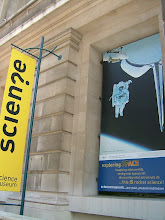SPACETIME:Einstein 1, Quantum Gravity 0 Adrian Cho*
For 5 years, physicists have hoped that a flaw in Einstein's special theory of relativity might reveal that space and time aren't smooth at the smallest scale, but fuzzy and foaming. Now, that tantalizing prospect has vanished in a puff of gamma rays. Two independent measurements of cosmic gamma rays show that Einstein was right after all--and that current plans to detect the foam are doomed. "The results rule out these possibilities on empirical grounds," says Floyd Stecker, a theoretical astrophysicist at NASA's Goddard Space Flight Center in Greenbelt, Maryland.
The frothiness of space and time is predicted by many theories that attempt to meld Einstein's theory of gravity and quantum mechanics. Physicists hoped to detect it by finding a hole in Einstein's dictum that it is meaningless to say an object is moving or stationary relative to the universe, a principle known as Lorentz invariance. One consequence of the principle is that all particles of light, or photons, travel through empty space at the same speed regardless of how much energy they pack.
In recent years, however, various quantum gravity theories have suggested that Lorentz invariance might not hold. In that case, a photon's speed would vary with its energy, so that light of different wavelengths would travel at slightly different rates. That would make intuitive sense, says Giovanni Amelino-Camelia, a theoretical physicist at the University of Rome, La Sapienza. After all, when light flows through water or air, its speed depends on its energy; perhaps foamy spacetime has the same effect.
Researchers might spot the tiny differences in high-energy light that had traveled far enough for faster photons to pull ahead of slower ones. In 1998, Amelino-Camelia and colleagues suggested that astronomers scrutinize gamma ray bursts--enormous extragalactic explosions that last only seconds--for evidence that rays of different energy reach Earth at different times. Such data will be collected by NASA's Gamma-ray Large Area Space Telescope (GLAST).
But 2 years before the launch of GLAST, Stecker and others have shown that Lorentz invariance holds firm. Stecker and colleagues studied gamma rays from the hearts of the galaxies Markarian 421 and Markarian 501, some 450 million light-years from Earth. En route the rays pass through a thin haze of infrared photons that fill intergalactic space. If Lorentz invariance were violated, the gamma rays would zip right through the haze. According to special relativity, however, the highest energy gamma rays should collide with the infrared photons to make electron-antielectron pairs. This process should soak up gamma rays above a well-defined cutoff energy--just what the researchers observed, Stecker reports in a paper to be published in the journal Astroparticle Physics.
Gamma rays from the Crab Nebula also bear out Einstein's theory, gravitation theorist Ted Jacobson and colleagues at the University of Maryland, College Park, report in this week's issue of Nature. The rays come from extremely energetic electrons spiraling in the magnetic fields inside the gargantuan cloud of gas. If Lorentz invariance were violated, the electrons would slam up against a virtual speed limit slower than the speed of light. From the energy of the gamma rays, however, Jacobson and colleagues deduced that the electrons were traveling within a 10-billion-billionth of the speed of light--even stronger evidence that Einstein was right.
A loophole in special relativity "would have been great," Jacobson says. "We're desperate for some observational input into quantum gravity." But the new results are just that, says Lee Smolin, a theoretical physicist at the Perimeter Institute for Theoretical Physics in Waterloo, Canada. "I think it's great," Smolin says, "because it means that physically plausible hypotheses are being confronted with experimental data."
The results sink several quantum gravity theories, but not string theory, which assumes that every particle is a little loop of "superstring," or a leading alternative called loop quantum gravity (Science, 8 November 2002, p. 1166). Because neither requires violations of Lorentz invariance, both theories remain viable for now--and quantum gravity remains undetectable.
Originated from: http://www.sciencemag.org/cgi/content/full/301/5637/1169a?etoc
skip to main |
skip to sidebar
站在巨人的肩膀上 追尋著愛奧尼亞式迷情的源頭 找尋著存在的意義 心靈最深層的印記 烙印著傳承的使命 隨著宇宙萬物幻化 開啟不朽之殿堂









沒有留言:
張貼留言